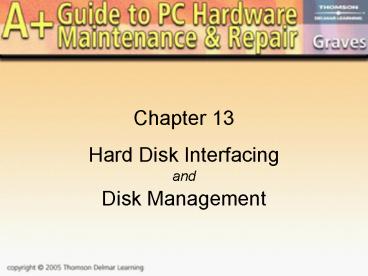A Guide to PC Hardware Maintenance and Repair PowerPoint PPT Presentation
1 / 21
Title: A Guide to PC Hardware Maintenance and Repair
1
Chapter 13 Hard Disk Interfacing and Disk
Management
2
- In this chapter youll get an overview of some
different interfaces used by disk drivers over
the years - Youll learn basic disk preparation
- Most importantly, you will learn some
preventative maintenance techniques to keep you
drives running smoothly
3
In the Beginning
- The first hard disks for the PC were the ST-506
and the ST-412 - MFM drives
- The ST-506 was a whopping 5MB. FIVE WHOLE
MEGABYTES!!! - IBM demanded something bigger.
- So the 10MB ST-412 was born
- MFM Drives required a data cable and a control
cable
4
ESDI
- Enhanced Small Device Interface
- Similar to MFM in technology
- Some of the controller circuitry moved over onto
the drive - Like MFM, required a specialized controller card
and two cables
5
IDE
- Integrated Drive Electronics
- All controller circuitry moved onto device
6
ATA
- Advanced Technology Attachment (First generation
IDE) - supported only 1 port
- 2 devices
- only hard drives
- due to an addressing issue, the largest drive
supported was 504MB - Used Programmed Input/Output (PIO)
- CPU had to negotiate the transfer of each packet
of data
7
ATA-2 and 3
- Eliminated addressing error
- now supports drives up to 8GB
- Introduced Multi-word DMA
- Once the CPU negotiated the transfer of data from
the drive to memory, it stepped aside and let the
data flow - Introduced Logical Block Addressing (LBA)
- An Int13h extension that allows hard drives up to
137GB
8
What is EIDE?
- It was never an industry standard
- Western Digital incorporated some features that
would eventually become a part of ATA-2 - Not all of WDs features would be accepted as an
industry standard - Still, the term took hold
9
ATA-4
- Introduced a more efficient command set
- Incorporated cyclical redundancy checking (CRC)
error correction - Introduced Command Queuing and Command
Overlapping to the world of IDE - Bumped theoretical speeds to 66Mb/s
10
ATA-5
- Merely a tweak for ATA-4
- bumped speeds to a theoretical 100Mb/s
- improved the command set
11
ATA-6
- Increased the address bus to 64-bits
- this allows drives up to several hundred
terabytes - Bumped speed to a theoretical 133Mb/s
- New command set supports video streaming
12
Serial ATA
- Takes IDE drives off a parallel cable
- data throughput increases dramatically
- Only a single device per cable prevents two
devices from competing for bandwidth - A very small footprint allows multiple ports to
occupy less motherboard real estate than 40-pin
connectors - Differential gigabit technology speeds throughput
13
Hard Disk Preparation
- Physical Installation
- Preparation of MBR and partitioning
- High-level format
14
Installation Issues
- Masters and Slaves
- Modern computers have two IDE ports
- Each port can support two devices
- One device must be the master
- One device must be the slave
- IDE devices have jumpers
- Master, Slave or Cable Select settings
15
More Installation Issues
- Two devices on one cable
- Both cannot be set to master or slave
- If set to cable-select, the position on the cable
dictates which drive is master and which is slave
16
A Word on Cable-Select
- 40-conductor Cables
- Not all are cable select. For a cable to be CS,
the 28th wire will be clipped - The middle connector becomes the master device
- 80-conductor Cables
- All are cable-select by default
- The end connector is the master
17
Another Word on Cable-select
- If a cable-select cable is used, the drives
should both be set to CS - If the drives jumper setting conflicts with its
position on the cable it will not be recognized
at all
18
Partitioning the Drive
- FDisk
- Used for all FAT file systems
- Prepares the MBR and allows the user to configure
partitions - 16-bit FDisk only supports FAT16
- 32-bit FDisk supports FAT16 and FAT32
19
Formatting a Drive
- The high-level (OS) format maps out the FAUs on
the drive - The first format should NEVER be a quick format
- A standard format tests the integrity of each FAU
before writing its information to FAT
20
Hard Disk Maintenance
- Scandisk
- Checks file system for errors
- Cross-linked files
- Lost File Fragments
- FAT Entry Errors
- Can scan surface for bad sectors
21
DeFrag
- Takes files that have been fragmented all over
the drive and makes them contiguous - Should be run in Safe Mode so fewer files are
open by the OS - Cannot be run if there are bad sectors. ScanDisk
must be run first

